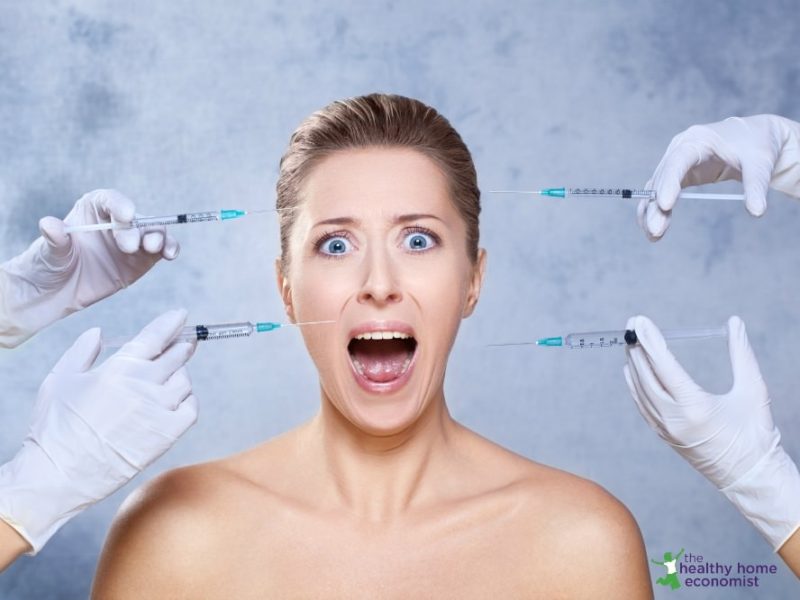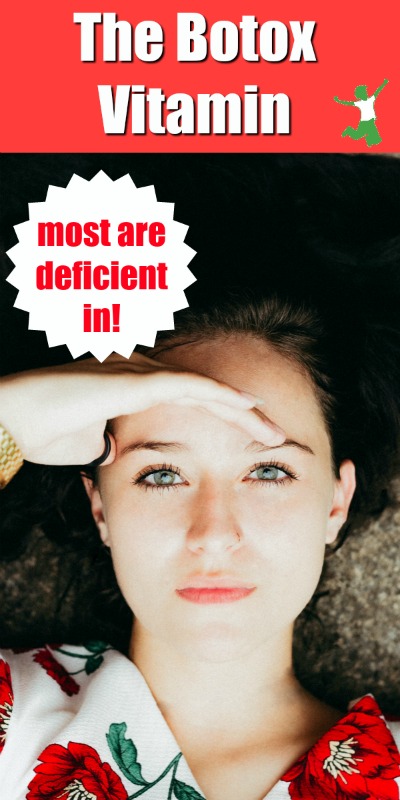Table of Contents[Hide][Show]
The vitamin deficiency that is widespread and most tellingly shows up as excessive wrinkling of the face.

Are wrinkles an inevitable fact of aging, or could laugh lines and crow’s feet potentially indicate a vitamin deficiency or even a more serious underlying health issue?
At a meeting of the Endocrine Society in Boston, researchers presented findings that revealed that women in their 40s and 50s who have extensive skin wrinkling are much more likely than their peers to have low bone mass. (1)
Researchers noted the relationship between wrinkles and bone density in every single bone tested which included hip, heel, and lumbar (spine).
In addition, this relationship existed regardless of body fat percentage and age.
Epidemiological evidence of Asian women offers further health clues to the wrinkle mystery. (2)
It is known that Japanese women have fewer wrinkles and less skin sagging that women of the same age living in North America.
These two groups of women vary greatly in diet and lifestyle, however.
Even when Japanese women living in Tokyo were compared with women from the Asian cities of Shanghai and Bangkok, they showed the least visible signs of aging.
Diet and lifestyle factors for these three Asian groups of women are comparable, except for one notable exception: consumption of natto in Japan.
Vitamin K2. The Anti-Wrinkle Vitamin
Tokyo residents frequently enjoy natto, a strong-smelling food traditionally made from fermented soybeans for breakfast.
Natto is loaded with menaquinone, more popularly known as Vitamin K2, and blood samples of the Tokyo women revealed high circulating levels of this fat-soluble vitamin.
Soy-free natto is also high in K2, as it is the specialty probiotic culture that imparts the nutrient, not the legume itself.
Further research bolstering the notion that getting plenty of anti-wrinkle vitamin K2 in the diet makes for smoother facial features is found in the research of Korean scientists and was published in the journal Nephrology. (3)
The rate at which the kidneys are able to filter the blood is an important measure of overall kidney function.
Researchers found that reduced renal filtration rate was associated with increased facial wrinkling.
What does decreased kidney filtration rate predict?
You guessed it – Vitamin K2 deficiency, according to American research published the year after the Korean study.
90% Deficiency Rate!
Testing has been limited so far on the true extent of Vitamin K2 deficiency in the western world.
However, of the testing conducted so far, a whopping 90% of people are deficient in this critical nutrient.
No wonder botox is such a popular cosmetic treatment!
No surprise that the sacred foods of traditional cultures were some of the highest Vitamin K2 containing foods!
Foods with the Anti-Wrinkle Vitamin
If you want to avoid a vitamin deficiency of K2, know that it is an elusive nutrient and extremely difficult to obtain with a modern diet.
The highest sources of K2 are:
- Natto (fermented soybeans)
- Goose liver
- Certain cheeses (Gouda has the most K2)
- Animal fats like egg yolk, butter, butter oil, ghee, and lard which must come from grassfed animals.
Natto contains 1,103 mcg of K2 per 3.5 ounce/100 gram portion which is far higher than any other food.
The second highest food in Vitamin K2 is goose liver pate which has 369 mcg per 3 1/2 ounce portion.
While delicious and wonderful to eat, goose liver pate is very hard to find in most places. It is also a very high-end, gourmet food, which makes the price out of reach for most.
Rounding out the top 3 foods highest in Vitamin K2 is none other than the humble Gouda cheese, which boasts 75 mcg per 3 1/2 ounce serving!
Brie contains significant K2 as well.
This compares to pastured egg yolks and butter, which each have about 15 mcg of K2 per 3 1/2 ounce portion.
How much of these K2 containing foods should you eat to avoid a vitamin deficiency of this critical nutrient?
That part gets murky as the official recommended daily intake (RDI) of Vitamin K doesn’t distinguish between K1 and K2 despite their very different uses in the body.
The RDI for Vitamin K is only determined by the liver’s requirement for normal blood clotting factors, not the K2 needed for optimal bone and kidney health and wrinkle-free skin.
Thus, getting enough K1 in the diet via leafy greens could still mean a serious deficiency of Vitamin K2.
There is also no solid evidence that the human body is able to convert Vitamin K1 to Vitamin K2, which is what occurs in grazing animals.
The good news is that there is no known toxicity of Vitamin K2, unlike other fat-soluble vitamins.
So, eating generously of Vitamin K2 rich foods as practiced by Traditional Societies and even potentially taking a supplement to avoid a vitamin deficiency is considered wise by Dr. Kate Rheaume-Bleue, ND, author of Vitamin K2 and the Calcium Paradox.
Plant vs Animal K2
Vitamin K2 is available in both animal fats and fermented foods. The animal form is MK-4 and the fermented form is MK-7.
Recent research has shown that emu oil, an Aboriginal sacred food, is extremely high in MK-4, nearly as high as goose liver pate!
This vetted source of pastured emu oil from a genetically pure strain of birds eating their native diet is the type to source.
Some people claim that putting emu oil directly on the skin is also helpful for anti-wrinkling effects. It certainly can’t hurt to try this, but I would not rely on transdermal emu oil alone. Eating high Vitamin K2 foods regularly is crucial.
Note that not all emu oil contains K2…only the fat from pastured birds!
For those who prefer the fermented form of K2 (MK-7), this quality brand offers therapeutic doses of the wrinkle-reducing vitamin from nonGMO natto extract.
As for me, I prefer to get nutrients from food as much as possible. While I will take Vitamin K2 supplements in a pinch, I am currently eating 1-2 tablespoons of homemade natto (MK7 form of Vitamin K2) and 1/2 teaspoon of grassfed ghee (MK4 form of Vitamin K2) every day as my whole food sources. When combined with a traditional diet, this provides about 200-400 mcg of Vitamin K2 per day.

(1) No Joke! Laugh Lines May Reveal Bone Health
(2) Vitamin K2 and the Calcium Paradox: How a Little-Known Vitamin Could Save Your Life
(3) Facial wrinkles as a predictor of decreased renal function
More Information
The Best Vitamin K 2 Supplement
Benefits of Vitamin K2
Macrobiotic Diet and Extreme Vitamin Deficiency
Emu Oil Benefits







Does anyone have the link to the study from the Korean scientists published in the 2008 journal of Nephrology which demonstrated that consumption of vitamin K2 correlates with lower levels of skin wrinkles, ie. smoother skin? I would really love to read it.
Sarah, may I ask why you say that the k2 would not be affected by pasteurization (if the Gouda cheese was made from pasteurized milk)? It sounds counter-intuitive to me, as most vitamins are destroyed by heat and pasteurization is extrmely high heat. Would appreciate clarifying this, as I’d love to get my k2 from Gouda..
Water soluble vitamins like vitamin C and the B vitamins are negatively affected by heat. However, the fat soluble vitamins A, D and K2 are more heat resistant and remain intact. This is one of the reasons why pasteurized butter is fine to consume (although raw butter is better due to the presence of enzymes and probiotics), but pasteurized milk should be avoided as it is nutritionally inferior to raw milk (in addition, the proteins in raw milk are denatured by the heat making it very allergenic).
That’s why the study used 3 different asian groups as their subjects….
Is emu oil good for a person with histamine sensitivity?
I am all for vitamin K2, and have been using it for the past ten years, but I do get more than a little annoyed when people correlate the fact of Asian women having less wrinkles and sagging to their diet only. The MAIN reason is the fact that Asians in general have a significantly thicker layer of subcutaneuous fat. It’s a racial trait. (Just like black people have a thicker dermis than Caucasians.)
Otherwise I am quite appreciative of this article, so thank you and keep up the good work.
I am so glad that I skimmed this article and learned that Vitamin K is connected to kidney function and the filtration rate. I had not known that before, and I’ll go look into it now online.
Even though there is no obvious reason for it, my filtration rate, which has always been quite good and steady, suddenly started declining a couple of years ago, and my doctors say that it’s still within normal levels for my age, so they aren’t worried at all about it. But just because my current rate is not abnormal for the average (unhealthy) person in the US, it doesn’t mean that I am going to be sanguine about seeing these sudden declines in kidney function from blood test to blood test, every single time — and for no apparent reason.
K1 never worked for me, and K2 mk-7 gives me problems, so I have not been taking K as a supplement until this year.
In the last year, with a diagnosis of osteopenia (I am still menstruating, so it’s a bit early for that), I decided to take the level of mk-4 that was used in some studies to improve bone health (1500 mcg per day).
I can’t have another bone scan for 18 months, so it will be a while before I will know whether my self-researched interventions, such as the 1500 mcg of mk-4, for my bones are doing any good.
But, if K2 is also good for the kidney function, maybe I’ll see an improvement in my filtration rate — and I have those tests every 4 months (for a completely separate health issue), so I won’t have to wait 2 years for feedback about that. If it helps, that would be great.
Only wanna say that this is invaluable, Thanks for taking your time to write this.
Conventional egg yolk and butter contain 15 mcg/100 g. Grass-fed egg yolks and butter oil contain about twice as much, 30 mcg/100 g, and grass-fed butter contains 20 mcg/100 g. You don’t *need* to eat grass-fed to get vitamin k2, but it is more concentrated in grass-fed.
Homemade sauerkraut is full of K2…I make a crock of it every 6 months. Let it ferment in the crock for 3d to 4 weeks then store it in mason jars in the fridge. Eat about 1/4 cup of it every day…like you would cole slaw. Never heat it…it will destroy all the good probiotics. Yummy stuff.
Yes, there is K2 in sauerkraut, but not large amounts. 🙁
I had a allergic reaction to k2 natto supplement after 7 days taking it: rash,palpitation,dizziness,shortness of breath
What could I take instead that is high in k2 vitamin?
X factor butter oil or emu oil. Here’s where I get mine (I take these plus the K2 natto also) http://www.radiantlifecatalog.com/product/high-vitamin-butter-oil/fish-butter-oils/?a=58537
http://www.radiantlifecatalog.com/product/walkabout-australian-emu-oil-capsules/healthy-fats-oils/?a=58537
Are those mk-7 like natto(fermented)
This is to help my ostoporosis
Doesn’t make sense, you would have not been able to take it for a week and have that kind of reaction. It had to be something else.